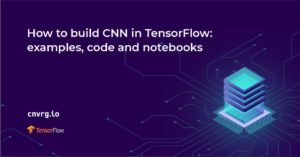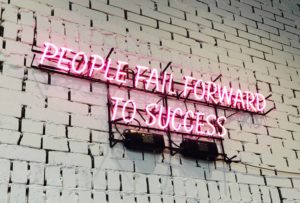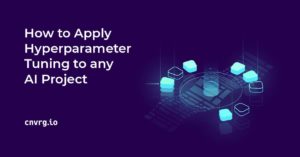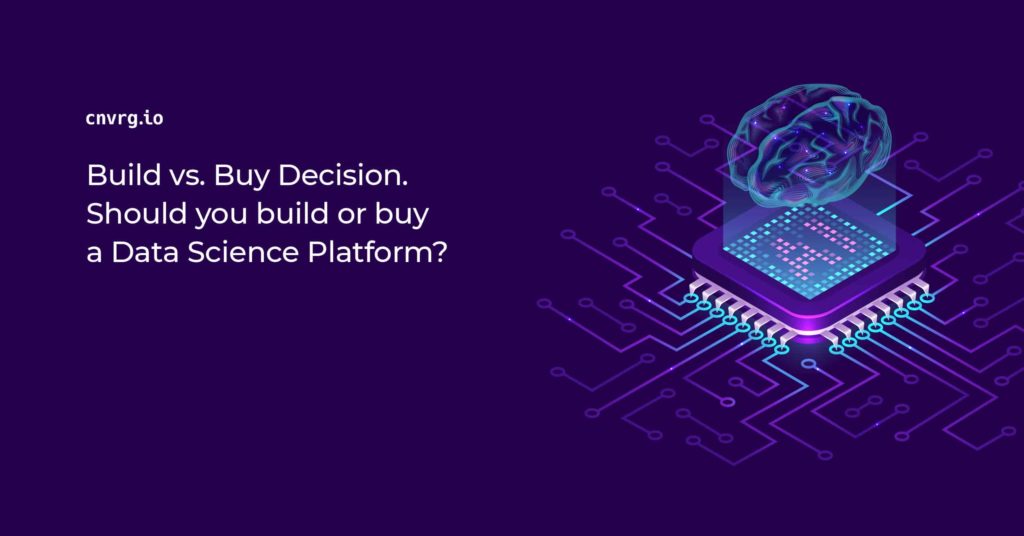
Considering whether to build an inhouse machine learning platform or buy out-of-the-box? Let the numbers decide
Machine learning has matured over the last few years. Data science teams demand more from their machine learning infrastructure. We’ve spent years building and iterating our advanced MLOps solution and continue to transform machine learning workflows with an out-of-the-box machine learning infrastructure. We’ve collected data and testimonials from enterprises on their AI journey, and have compiled an infographic with some numbers that might help your team decide between building or buying an MLOps solution. In this post we will share a few insights and things to consider when deciding whether to build an inhouse machine learning infrastructure or buy an out-of-the-box MLOps solution.
You can download the full infographic as a PDF here.
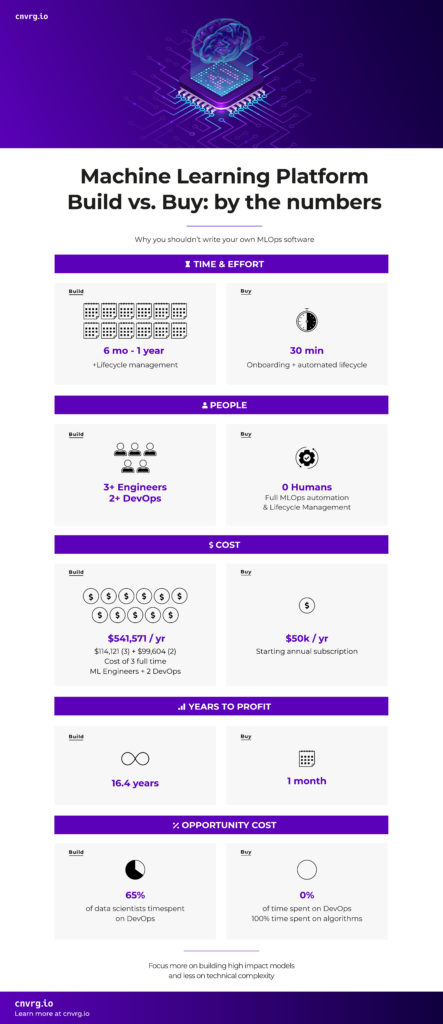
Why you shouldn’t build your own MLOps software
We get it. As data scientists, we naturally are builders and problem solvers. If we want to solve a problem, we simply build our own solution. In most cases we have the skills, tools, and knowledge to do so. Before switching to cnvrg.io, many of our customers already had internal data science systems or were in the process of creating one. As their needs for the platform became more complex, they decided to seek alternative solutions. Instead of building a full stack data science platform from scratch, they decided to invest more time building models and solving complex problems.
Time and effort
Customers have reported that prior to using cnvrg.io, they either were in the process of building their own machine learning infrastructure, or were using existing platforms that didn’t quite have all the solutions they needed. The data scientists often spent their time building solutions to add on to their existing infrastructure so that they could complete projects. 65% of their time was spent on engineering heavy, non-data science tasks such as tracking, monitoring, configuration, compute resource management, serving infrastructure, feature extraction and model deployment. This wasted time is often referred to as ‘hidden technical debt’, and is a common bottleneck for machine learning teams. Building an in house solution or maintaining an underperforming solution can take from 6 months to 1 year. Even once you’ve built a functioning infrastructure, just to maintain the infrastructure and keep it up to date with the latest technology requires lifecycle management and a dedicated team. cnvrg.io has enabled data science teams to focus on building algorithms and has accelerated time to production with a modern out-of-the-box infrastructure and full lifecycle management.
Human resources
Operationalizing machine learning requires a lot of engineering. In order to have a smooth machine learning workflow, each data science team must have an operations team that understands the unique requirements of deploying machine learning models. A typical AI team has a dedicated team of engineers and DevOps to manage resources, microservices, clusters and more. Investing in an end-to-end MLOps platform, these processes can be completely automated, making it easier for operations teams to focus on optimizing and maximizing utilization of their infrastructure. cnvrg.io helps get more models to production by automatically packaging your models as a REST API endpoint in one click leveraging Docker containers and your Kubernetes clusters. It also automates model versioning, provides advanced monitoring mechanisms with CI/CD integration and advanced triggering to retrain models while in production.
Cost
Having a dedicated operations team to manage models can be expensive on its own. At ST Unitas, cnvrg.io replaced the need to hire an entire team of 10 engineers to manage the hundreds of experiments and vast array of resources they had in their organization. Before using cnvrg.io, their system was simply not scalable. If they wanted to scale their experiments and deployments they needed to hire more engineers to manage this process which was a major investment and slow process to find the right team. An out-of-the-box MLOps solution is built with scalability in mind at a fraction of the cost. After calculating all the different costs associated with hiring and onboarding an entire team of engineers, your return on investment also decreases which brings us to our next factor.
Time to profit
It can take over a year to build a functioning machine learning infrastructure, and often can take longer to build a data pipeline that can produce value for your organization. Companies like Uber, Netflix, and Facebook have dedicated years and massive engineering efforts to scale and maintain their respective machine learning platforms to stay competitive. For most companies, an investment like this is not feasible nor is it necessary. The machine learning landscape has matured since Uber, Netflix and Facebook originally built their inhouse solutions. There are more pre-built solutions that can offer all of the tools you need to operationalize your machine learning out-of-the-box at a fraction of the cost. cnvrg.io customers are able to deliver profitable models in less than 1 month. Instead of building all the infrastructure necessary to make their models operational, the data scientists are able to focus on research and experimentation to deliver the best model for their business problem.
Opportunity cost
As we mentioned before, it’s reported that 65% of a data scientist’s time is spent on non-data science tasks. Using an MLOps platform automates technical tasks and reduces DevOps bottlenecks. Data scientists are able to spend their time doing more of what they were hired to do – which is to deliver high impact models while cnvrg.io takes care of the rest. Adopting an end to end MLOps platform has a considerable competitive advantage that allows your machine learning development to scale massively.
Conclusion
As data scientists, we are naturally builders and problem solvers. If we want to solve a problem, we simply build our own solution. In most cases we have the skills, tools, and knowledge to do so. Before switching to cnvrg.io, many of our customers already had internal data science systems or were in the process of creating one. As their needs for the platform became more complex, they decided to seek alternative solutions. Instead of building a full stack MLOps platform from scratch, they decided to invest more time building models and solving complex problems.
cnvrg.io was built by data science professionals that understand the unique challenges that data scientists face when operationalizing their machine learning models. It was designed to be agnostic and code-first so that teams can work with the tools and languages they already use, in any environment. Our mission is to help data scientists spend less time on DevOps tasks, and focus more on delivering high impact ML solutions. cnvrg.io provides teams a flexible, elastic MLOps tool that uses containers to spin up the environment that they want, and streamlines the entire ML workflow.
If you’re interested in learning about how cnvrg.io can accelerate your existing machine learning workflow and upgrade your machine learning infrastructure you can reach out to one of our machine learning specialists.

